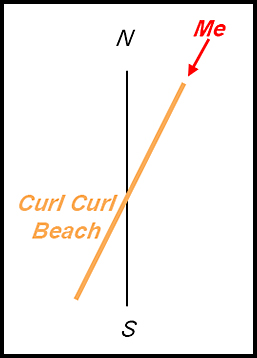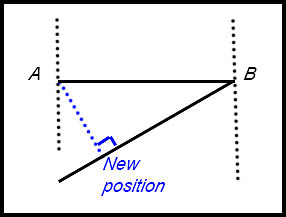Where the techniques of Maths
are explained in simple terms.
Trigonometry - Bearings (compass and true).
Test Yourself 1.
- Algebra & Number
- Calculus
- Financial Maths
- Functions & Quadratics
- Geometry
- Measurement
- Networks & Graphs
- Probability & Statistics
- Trigonometry
- Maths & beyond
- Index
| Conversions from compass to true bearings. | 1. Convert the following compass bearings to true bearings: | |
| (i) South
(ii) West (iii) North west (iv) North east. |
(v) North north east (NNE)
(vi) West south west (vii) East 25° south (viii) West 15° north |
|
| Conversions from true to compass bearings. | 2. Convert the following true bearings to compass bearings: | |
(i) 0° T. (ii) 270° T. (iii) 135° T. (iv) 020° T. |
(v) 210° T. (vi) 310° T. (vii) 157.5°. (viii) 202.5°. |
|
| Bearings "looking back" FROM | 3. The compass bearing of Point A from Point B is N38°E.
Answer.Bearing of B is S38°W from A or W52°S. |
|
| 4. A ship sails from Point A at a bearing of 090° to point B. It then changes bearing and sails along a course at 240°.
What will be the bearing of the ship from point A when the ship travelling on its new course is at its closest distance to point A? Answer.Bearing of 150° from A. |
||
| 5. The compass bearing of A from B is S42°E.
What is the compass bearing from B to A? Answer.Bearing from B to A is N42°W or W48°N. |
||
| 6. | ||
| Bearings in right angle triangles. | 7. A ship travels 150 km in a north 40° west direction.
Answer.(i)North: 115 km. (ii) West: 96 km. |
|
|
||
| Bearings with other rules. | 11. A ship S sails from port P on a bearing of N 60° E for 56 kms.
Another ship A also leaves port P but on a bearing 110° T for 48 kms.
|
|
12. Three ships start from Port O.
Answer.(ii) AB = 72 nm. (ii) Bearing of C from B is 338°T. |
||
13. The diagram below shows three towns, A, W and B. A plane travelling from town A to town B must make a stop-over at town W. Town W is 120 km on a true bearing of 312° from town A. Town B, which is directly north of town A, is on a true bearing of 042° from town W.
Answer.(ii) 253 - 179 = 74 km. |
||
14. A course for a Championship Drone event requires competitors to fly from point A on a bearing of 050° for 1.2 km over cliffs with significant updrafts to point B. From point B they must then fly on a bearing of 230° over land for 2.8 km to point C.
|
||
| 15. I am looking at Curl Curl beach from a headland. I know that the beach faces east south-east and I draw a small sketch as shown below. | ||
|

Answer.(i) True bearing is 112.5°. (ii) Bearing to me FROM beach is 22.5°. (iii) Bearing of Beach from me is 202.5°T or S22.5°W. which is SSW. |
|
